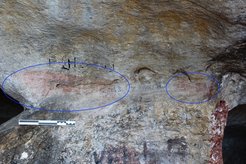Research Reveals Recent Origins of Cave Art in Malta
The human history of Malta, with its megalithic temples and rich archaeological record, has long fascinated both researchers and the general public. While the “Temple Period” and its associated structures have been the subject of much research, less is known about how the prehistoric peoples of Malta made use of caves.

At Għar Ħasan, a cave in southern Malta, prehistoric rock art was first reported in the 1980s, but no scientific investigation was ever undertaken, and substantial doubts remained about the true age of these pigments. In a recent paper published in the Journal of Archaeological Science: Reports, a team of researchers used a range of non-invasive methods, including portable energy-dispersive X-ray fluorescence spectrometry (p-ED-XRF) and visible (VIS) and near-infrared (NIR) spectroscopy to assess the pigment traces.
Their analysis showed that most of the previously reported cave paintings were produced in the last century. Indeed, the site is frequented by both locals and tourists, and more recent graffiti, as well as damage from scraping, scratching, rubbing, and campfires is evident through the cave’s walls.
However, the researchers identified one painted area may that predate the last century, but vandalism and other destructive processes make a definitive assessment challenging. The pigments used in the area in question showed different characteristics than the more recent paintings, but had sustained so much damage that definitive aging was impossible.

“Given that one of the two painted shapes is found framing a doorway that was likely cut during the Classical period, it is unlikely that they date to prehistory – but we can’t rule it out entirely,” says Dr. Maria Guagnin, researcher with the Department of Archaeology at the Max Planck Institute of Geoanthropology.
In addition to answering questions about paintings at Għar Ħasan, the authors hope that the recent study will inform and guide future efforts at rock art identification and conservation. The study shows that invisible traces from degraded spray-paint introduce substantial uncertainty to scientific analyses. In this context, the use of low-tech, low-cost methods such as digital microscopy and DStretch provided valuable information on the presence of degraded spray paint and very small droplets which can skew more sensitive analyses. At Għar Ħasan, spray paint was also shown to have very limited durability, becoming invisible, and even undetectable within the time frame of a few decades.

